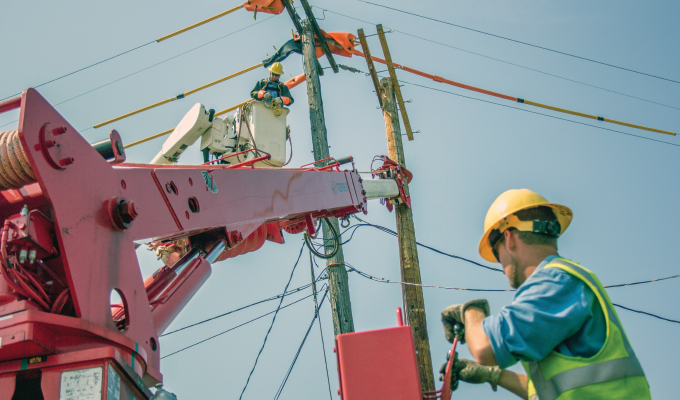By Jack Johnson
Over half of US states have anti-idling regulations in place, and many fleet directors need solutions that adhere to environmental laws without impacting vehicle and worker performance. Infrastructure improvements like nationwide electric vehicle (EV) charging are gaining traction.
Though the pathway to consumer vehicle electrification grows more evident, the course for heavy-duty utility vehicles remains shrouded. According to Popular Science, the US faces more electrical outages than any other developed country. If fully electric utility vehicles must complete work in an area without power, they risk the inability to complete their task with enough energy for the return trip.
Fleet directors face a dilemma: Their current diesel fleets aren’t compatible with anti-idling regulations, but a fully electric fleet is more costly, logistically complex, and carries many hidden costs in infrastructure. On the other hand, continued investment in diesel-only solutions risks current vehicles becoming stranded assets if regulations advance rapidly.
Contrary to popular belief, the choice between diesel and electric is a false dichotomy, and they aren’t the only viable options for idling elimination. A hybrid auxiliary power system—that is, one independent of the drivetrain—can deliver the triple bottom line that managers need.
If utilities want to create meaningful, practical, lasting changes in their operations, they must balance environmental, social, and economic sustainability. Hybridized auxiliary power is a flexible solution that allows utilities to strike that balance as a cost-effective way to eliminate idling, both retroactively and in new vehicles.
ENVIRONMENTAL
An analysis by the US Department of Energy showed that eliminating vehicle idling would equate to removing 5 million vehicles from the road. Based on average calculations, each diesel utility vehicle outputs approximately 800 lbs of CO2 per week solely through idling at jobsites.
Over time, the impact of eliminating idling compounds grows greater in its effect. If a utility fleet hybridizes 12 of their fleet vehicles, they’ll prevent over half a million pounds of CO2 that otherwise would have gone into the atmosphere. Over 20 years of vehicle usage, that’s over 10 million lbs saved by hybridizing a handful of vehicles.
SOCIAL
Hybridizing a fleet also protects both employee and public health and safety. The high decibel threshold produced by idling vehicles or generators can interfere with clear conversation between workers. This miscommunication leads to accidents or mistakes, potentially putting employees and others in harm’s way. By eliminating excess noise, utilities can ensure greater safety on jobsites. In addition, a worksite free of noise and fumes is a more favorable environment for attracting and retaining great employees and electricians.
The lack of idling noise benefits utility customers, too. Idling noise can lead to low customer satisfaction scores, complaints, and even fines in states or cities with strict anti-idling laws. A hybridized system enables workers to quietly restore service quickly, even during third shift, without disrupting neighborhoods or sleep.
Finally, vehicle emissions negatively impact human health. According to the United States Environmental Protection Agency, excessive exposure to vehicle and generator emissions can cause respiratory issues, headaches, nausea, and fatigue. The International Agency for Research on Cancer (IARC) also identifies diesel exhaust as carcinogenic, or cancer causing. With electric or hybrid systems, it’s possible to eliminate most worker exposure to diesel vehicle emissions and prevent the associated health issues.
ECONOMIC
Dealers can retrofit most auxiliary power systems to already-owned diesel vehicles, eliminating the need to idle at a jobsite for a fraction of the cost of going full EV. The popularity of hybridized utility vehicles is growing as a cost-effective first step toward a more sustainable fleet with rapid ROI potential. For example, a Volta Power System can quickly achieve total ROI in under two years, saving upward of $14,000 annually per fleet vehicle on maintenance and fuel.
Even so, moving forward with unproven vehicles can pose a significant risk to operations for fleet managers working within a set budget, though others are already implementing them successfully. In 2018, Oklahoma Gas and Electric (OG&E) integrated Volta systems into several bucket trucks that currently operate in the field. This eliminated the need for utility vehicle idling during the workday, managing hydraulic systems and other power tools on an auxiliary power system instead.
OG&E is now operating about a dozen vehicles with a Volta system. Utilities with 12 vehicles running full-day shifts could save an estimated $170,000 annually in maintenance and fuel costs. This would also prevent approximately 52,000 miles of idling engine wear and tear on each of the company’s Volta-equipped vehicles, reducing the frequency of preventive maintenance.
IDLE-FREE FUTURE
While anti-idling compliance may be a difficult challenge for many fleet managers, it’s also an opportunity to explore the best path for beginning to electrify your lineup. For utilities waiting to take the plunge into a fully electric fleet, hybridization may be the best first step toward a genuinely sustainable idle-free fleet.
ABOUT THE AUTHOR
Jack “JL” Johnson is the founder and chief technology officer of Volta Power Systems. Johnson is a visionary entrepreneur who is adept at finding the value and potential in challenging opportunities. He has spent his career driving innovation and process improvement with a refined focus on lean manufacturing and processes. Founded in 2014, Volta provides safe, powerful, and simple lithium-ion energy storage solutions for small to midsize businesses. Find out more, visit www.voltapowersystems.com.




